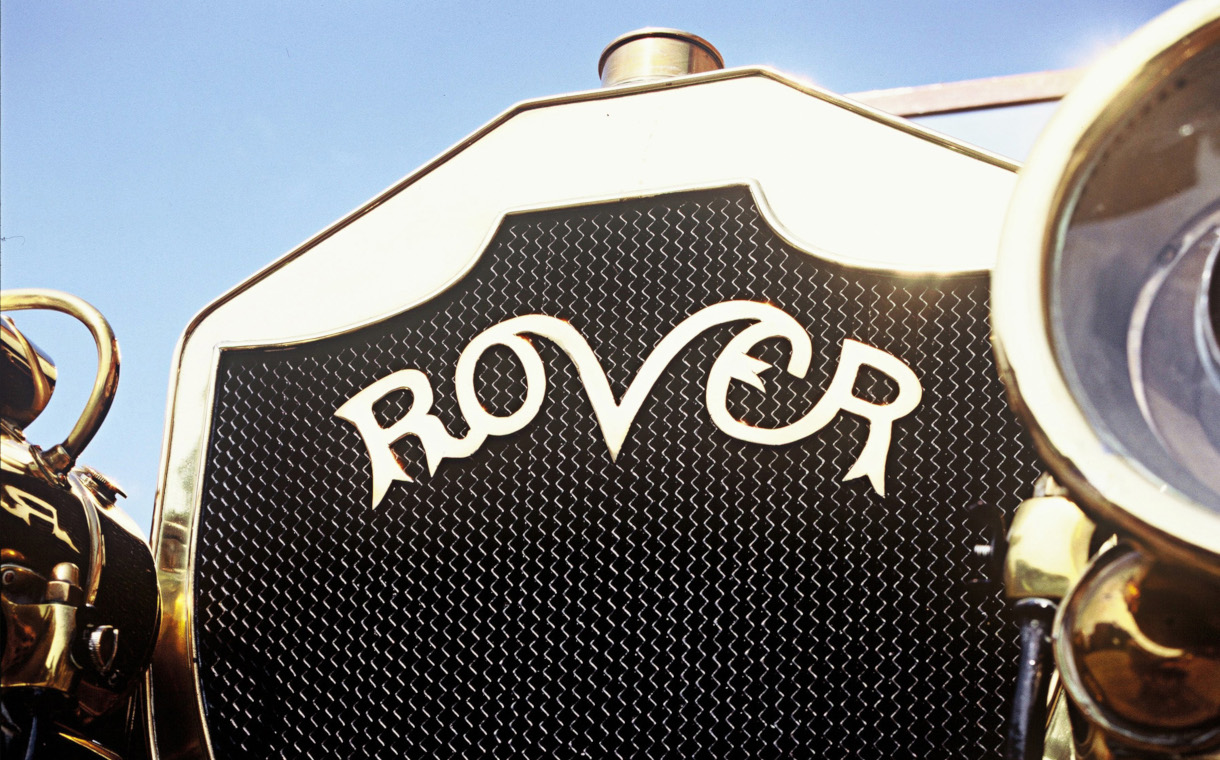
ROVER 16/20hp
The successful "Tourist-Trophy" - Winner
1905 - 1910
A view of the radiator of the ROVER 16/20hp, model year 1907.
The Rover 16/20 hp is Rover's first four-cylinder model. It was introduced in summer 1905 at the same time as the Rover 6 hp. Its chassis is an extended version of that of the 6 hp, but differs in front axle construction and suspension from the latter as a transverse leaf spring is used. The wheelbase of 108 in (2740 mm) is quite large; some sources indicate that initially a version with a wheelbase of 99 in (2515 mm) was also offered. We could not verify this.
The car is twice as expensive as the Rover 8 hp and costs £400 as a Standard model with wooden spoke wheels (artillery wheels), £450 as a model with reinforced suspension for India and the colonies. The car is also offered as a chassis, the price for this is not known to us.
Rover offers the "Roi-des-Belges" type as standard bodywork. In the 1907 brochure, Rover declares that it will fulfil any buyer's bodywork request at extra cost. The same applies to paintwork and upholstery. As standard exterior colours, Rover offers both a two-colour paint in two shades of green ("Rover Green") and a one-colour paint in "Rover Red", but points out that special paintwork can be very expensive depending on the type of paint. Almost all colours" are available for the upholstery.
The engine, clutch and gearbox are in an aluminium housing, hence the long bonnet. The radiator grille of the early cars up to 1907 corresponds to that of the smaller models. On the winning car of the Tourist Trophy in May 1907, the heart-shaped fairing first appeared, which later became the trademark of Rover. The car, which was led to success by chief tester Ernest Courtis, was equipped with spoked wheels, four-speed gearbox and double ignition. The car is reported as 20 hp. In June 1907, after the Tourist Trophy, the engine is enlarged by a larger bore and now classified as 20 hp by the RAC.
The series model also shines with extraordinary solutions. The engine brake is again advertised as the main brake, while the rear brakes can be activated by foot pedal. As an emergency brake, a belt brake can be activated by hand lever - on the outside of the body - which acts on a drum on the cardan shaft. All control elements - gear shift, ignition - are mounted on the steering column fairing.
From 1908 a 'TT' special model with the equipment of the winning car (wire spoke wheels, four-speed gearbox, double ignition) is offered for £450. In addition a new version with Landaulet body, wheelbase 120 in (3084 mm), is offered. There is no information available about this.
Already in his brochure for the 1907 season Rover can point to some successes of the 16/20 hp in the popular "Trials" and "Hill Climbs".
| London - Edinburgh | Two first places and gold medals |
| Mountain test, Snake Hill, Glossop | First place |
| Saltburn speed tests | Two championship titles and two gold medals |
| Kettlery Mountain Examination | Fastest Time |
| Blackpool racing series - £450 chassis category | second, victory over several Tourist Trophy vehicles |
Neither chassis numbers nor production figures are available for the 16/20 hp. It is estimated that between 40 and 50 cars were built per production year, a total of around 200 to 250.
The price development is stable, the "Red Book" reports for the period 1908 - 1910 constant £450 for the complete car.
| Sources | |
|---|---|
 | 1907 Rover Cars - Aut Optimum Aut Nihil - The Best or Nothing. The Rover Co., Ltd., Meteor Works, Coventry Includes also the Rover Cars 6 hp und 8 hp |
 |
Rover Enthusiast Magazine March 2007 |
 | 1908-1914 Motor Car Red Book |
 |
1910 Rover Brochure 6hp - 8hp- 12hp - 15hp - 20hp |
© 2021-2026 by ROVER - Passion / Michael-Peter Börsig

 Deutsch
Deutsch